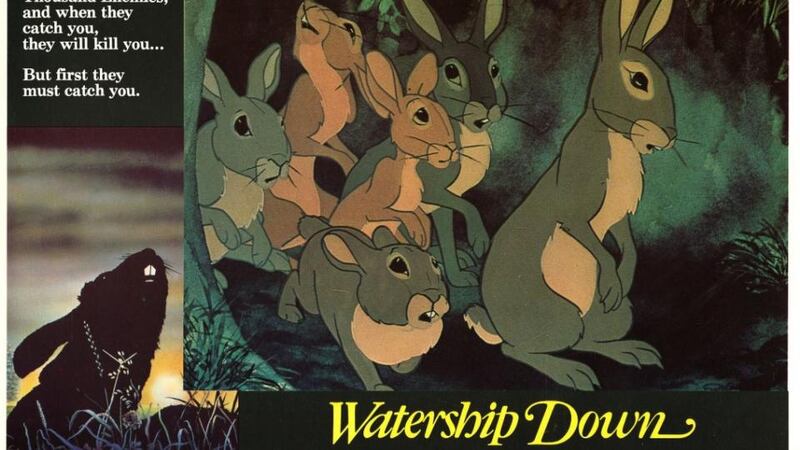It all begins with a sense of a coming apocalypse. Two brothers are sitting on a grassy bank in a May sunset. One of them moves off, the other, the smaller one, follows. He seems ill at ease and is described as having “wide, staring eyes and a way of raising and turning his head which suggested not so much caution as a kind of ceaseless, nervous tension”.
His mood infects the moment. The older brother has doubts of his own and hints at moving on elsewhere, but for him it is still just a thought. This shared awareness appears to settle the younger one who in attempting to explain his simmering distress says: “…it’s not exactly danger that I seem to feel about the place. It’s…something oppressive, like thunder.”
Then the pair notice some heavy wooden posts, a hammer and a few nails as well as the smell of a discarded cigarette. The random items are sufficient to further upset the younger brother, prompting him to say what he really senses: “There isn’t any danger here, at this moment. But it’s coming….look! The field! It’s covered with blood!”

There is no blood, only the light of the setting sun. But it’s enough. Natural instinct is usually right about these things. In the manner of conquering armies of old, developers have arrived to threaten a beautiful, ancient landscape. The brothers are alarmed, but not because they are concerned environmentalists or property owners. They are rabbits and while life in their warren, their community, is over-regulated by the controlling Owslafa, the ruling clique, men also bring their specific dangers; guns, poison and barbed wire. It is time to move on.
Watership Down (1972) is a story about survival, practical common sense, fair play, loyalty and the natural need to procreate as understood by a very special rabbit, Hazel, a quiet chap of calm presence. His nervy little brother Fiver is a seer who also happens to be the runt of the litter which means it can prove difficult for him to be taken seriously by the other rabbits. Luckily Hazel does listen; he tends to give everyone a fair hearing. He is not the most athletic, nor is he flamboyant but he is sensible – a great quality to have in a crisis and one which Adams values.
In a large cast of colourful rabbits, several of whom have dominant personalities, the brothers are markedly mild, despite Fiver’s odd trances. Even so, their creator, Richard Adams, who has died aged 97, was so taken with these rabbit siblings, that he had intended on calling his book, Hazel and Fiver. His publisher thought otherwise, looking towards the landscape itself.
Critics have seized on the narrative, interpreting the book as an allegory of war, even to the extent of comparing the exodus of Hazel and friends from their original warren with the Jewish settlement in Israel. But Adams, born in 1920, the youngest son of a rural Edwardian doctor, has always dismissed this. JRR Tolkien before him had also consistently refuted claims that The Lord of the Rings was an allegorical work – an understandable assumption, after all, Tolkien had experienced the horrors of the Somme – and instead stressed his epic work was merely his way of testing his powers as a storyteller. Adams has similarly always maintained that Watership Down was begun to amuse his two small daughters at bedtime and also during long car journeys. One of the girls suggested he write it all down – and finally he did.
In time-honoured fashion it was rejected by various publishers and agents: in their wisdom the publishing experts felt that teenagers would not be interested in a book about rabbits, while younger children would not engage with the adult style of writing. Adams did not agree. He had not written the book for children. It was a story for anyone who wished to read it.
There appears to be a little bit of blunt, candid and super-brave Bigwig – my hero – in Adams, just as the prevailing logic and Englishness of his book, his writing, his characters are as apparent in his demeanour. His depiction of rabbit life is imaginative yet it is also close to the reality of animals who are dependent on their wits to find food, shelter and mates for breeding, while also remaining on the alert for foxes, owls and other predators. Most of all, Adams makes clear that while rabbits are peaceable they are also as prone to bitter territorial disputes and bloody battles for power as much as all other living species.
As a child Adams had loved The Tales of Beatrix Potter and was particularly intrigued by Peter Rabbit. "I am Peter Rabbit," Adams, who has a lively sense of humour and remains an engaging speaker, has been known to declare.
On a more serious note, beyond his actual liking for rabbits, he was also intent on making his rabbit characters as true as possible to real-life counterparts. To do this he consulted RM Lockley’s The Private Life of the Rabbit (1964). Adams enjoyed a good friendship with the Welsh naturalist and ornithologist who died in 2000, aged 96. They co-authored a book, Voyage Through The Antarctic.
The young Richard Adams had entered Worcester College, Oxford in 1938 to read history. War intervened and he was called up the following year at 19 and joined the Royal Army Service Corps to serve in the First Airborne Division, making 10 parachute jumps. After six and a half years as a soldier he returned to Oxford and completed his history degree. Then he faced the arts graduate’s traditional options: the civil service or a career in teaching. Certain he would not be a good teacher, he sat the civil service exams and was offered a position in the ministry of housing and local government, later becoming assistant secretary in the department of environment. A passing piece of trivia: Adams was a co-author of the Clean Air Act (1968).
He married in 1949 and had two daughters, Rosamond and Juliet, his first audience and the reason Watership Down came into being. If his literary mentor is Rudyard Kipling, his life-long literary passion is Shakespeare. Describing writing as initially "bloody hard", he forced himself to write the story that would become Watership Down. His staunch English yeoman's disposition helped him through the rejections, making one suspect that there may be more of the mighty Bigwig or Thlayli, daredevil and erstwhile Owsla officer, in Adams that appears at first glance. No one could accuse Adams of pomposity. His common sense led him to a small publisher, Rex Collings, on noticing his reissue of Wood Magic (1881), the story of a little boy named Bevis and his engagement with the natural world.
Wood Magic was the work of Richard Jefferies, a Victorian writer of children’s books. Jefferies (1848-1887) died young. He shared that singularly English love of the natural world with which Adams too had grown up.
Collings had little money but he knew how to get the book reviewed; the notices were good and the small print run was quickly sold out. Once American publishers became involved, Adams’s financial future was secure; he could afford to retire from the civil service and concentrate on writing.
Shardik, his personal favourite of his own books, was published in 1974. The Plague Dogs followed in 1977, in which two dogs who escape from an experimental laboratory appear to revisit many of the themes of Watership Down, most obviously that of flight. It is a polemic and also includes a powerful condemnation of vivisection.
Watership Down, though, lives on in the imagination such is the vivid characterisation. The gentle Hazel is an unlikely leader, shrewd enough to befriend a very useful seagull named Kehaar. The bird with his guttural accent and black humour merits a book of his own.
An unsentimental decency runs through the story. The robust Bigwig, ready to take on all comers, is a swaggering hero. Yet despite his abrasive personality he cannot leave the humiliated Blackavar behind during the raid on Efrafa, General Woundwort’s zealously guarded warren, which Hazel hopes will secure females for breeding. Some critics have faulted Adams for presenting the doe rabbits as feeble creatures valued only for breeding. It is instead a realistic presentation; without them the warren and community will die out. Also he makes an effective use of the differences between the wild rabbits and their physically weaker domestic counterparts. This is underlined in one of the set-piece episodes when Hazel plots to free domestic rabbits kept in a hutch at a farm. The return visit proves shocking.
For all the lore and storytelling, the mythical presentation of death in the shape of a Black Rabbit despatched by Firth, a god figure and also the sun, it is a relatively realistic presentation of rabbits responding to danger, from water, from the threat of man and also attacks from rival rabbits. They simply wish to live in comfortable surroundings. A daring escape is made on a borrowed boat and there are many casual, if telling, instances of affection and also irritation.
Stylistically it is neither as ambitious nor as linguistically sophisticated as The Lord of the Rings, although many of the bluntly direct exchanges might well have been spoken by Bilbo Baggins in Tolkien's earlier classic, The Hobbit (1937). It is also very English, unmistakably English, more 1950s than 1970s, and that observation is not meant as a criticism. It feels to be from an earlier time, when life was more straightforward. That is part of the allure of Watership Down.
The rabbits are above all individuals; they have personalities and personal histories. They get injured, hurt and attacked. Death stalks the story. In General Woundwort Adams has fashioned a villain as enduring as Hazel and Bigwig and Co are beloved. Woundwort too has had his sorrows and sustains his mystery: “….no one ever found his body, so it may perhaps be that, after all, that extraordinary rabbit really did wander away to live his fierce life somewhere else…..And yet there endured the legend that somewhere out over the down there lived a great and solitary rabbit…If ever great danger arose, he would come back to fight for those who honoured his name.”
Perhaps Watership Down is about independence. Readers will see their own message in it. Life is reflected in the daily struggles of rabbits minding their own business. The story and its characters share a moral grandeur. You read it with your heart in your mouth and hope the rabbits won't drown, starve, get killed in battle, shot by a farmer or hit by a car, never mind taken by a fox or owl. You smell the blood of which much is spilt and you may find yourself shaking and shouting at Bigwig for taking so many stupid risks. More than anything you need to know what happens next. Isn't that what great stories are all about? Finding out what happens next? So take an interesting group of fugitive rabbits confronting nature and their needs in the English countryside and read on…
Eileen Battersby is Literary Correspondent of The Irish Times








